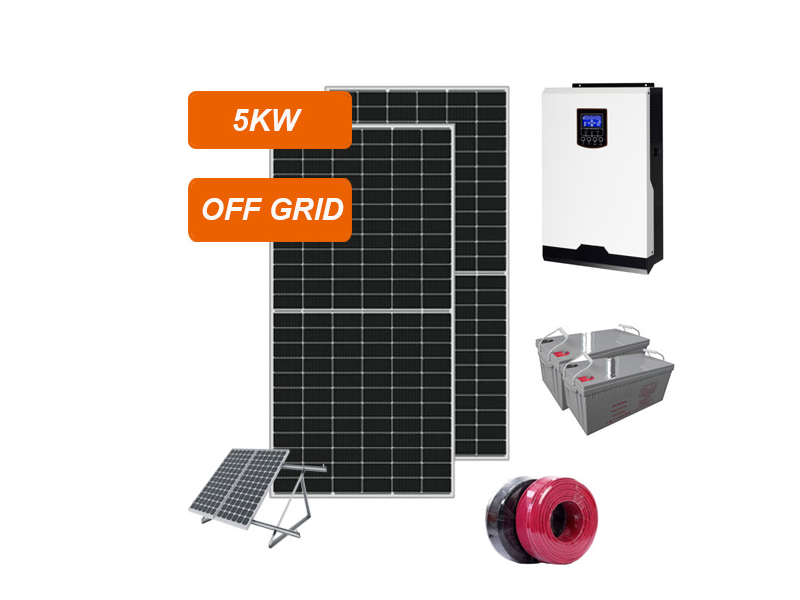Solar photovoltaic power generation systems are generally divided into five types according to different applications: grid-connected power generation systems, off-grid power generation systems, grid-connected energy storage systems, grid-connected energy storage systems, and multi-energy hybrid micro-grid systems.
1. Grid-connected photovoltaic power generation system
The PV grid-connected system consists of PV modules, PV grid-connected inverters, PV meters, loads, bi-directional meters, grid-connected cabinets, and power grids. PV modules generate DC electricity from light and convert it into AC electricity through inverters to supply loads and feed into the grid. Grid-connected PV system mainly has two modes of access to the grid, one is "self-generation, surplus power online", and the other is "full access to the grid".
Generally distributed photovoltaic power generation system mainly adopts "self-generation, surplus power online" mode, the electricity generated by solar cells gives priority to the load, when the load is not used up, the excess electricity is sent to the grid, when the power supply to the load is not enough, the grid and photovoltaic system can supply power to the load at the same time.
2. off-grid photovoltaic power generation system
Off-grid photovoltaic power generation system does not depend on the grid and operates independently, and is generally used in remote mountainous areas, powerless areas, islands, communication base stations, and street lights. The system is generally composed of photovoltaic modules, solar controllers, inverters, batteries, load, etc. The off-grid power generation system converts solar energy into electricity when there is light, supplies power to the load through the solar control inverter, and charges the battery at the same time; when there is no light, the battery supplies power to the AC load through the inverter.
It is very practical for areas without a grid or frequent power outages.
3. off-grid photovoltaic energy storage system
Grid-connected photovoltaic power generation system is widely used in places where there are frequent power outages, where self-generated photovoltaic power cannot be put online, where the price of self-consumption power is much more expensive than the price of online power, and where the price of peak power is much more expensive than the price of trough power.
The system consists of photovoltaic modules, solar grid-connected integrated machines, batteries, load, etc. The photovoltaic array converts solar energy into electricity when there is light, and supplies power to the load through the solar control inverter and charges the battery at the same time; when there is no light, the battery supplies power to the solar control inverter and then supplies power to the AC load.
Compared with a grid-connected power generation system, this system adds a charge/discharge controller and battery, so that the PV system can continue to work when the power grid is out, and the inverter can switch to an off-grid working mode to supply power to the load.
4. grid-connected energy storage photovoltaic power generation system
Grid-connected energy storage photovoltaic power generation systems can store excess power generation and increase the ratio of self-generation and self-consumption. The system consists of photovoltaic modules, a solar controller, a battery, a grid-connected inverter, a current detection device, a load, etc. When the solar power is less than the load power, the system is powered by solar energy and the grid together. When the solar power is greater than the load power, the solar energy partly powers the load and partly stores the unused electricity through the controller.
5. Micro-grid system
The microgrid is a new type of network structure, a distribution network composed of distributed power supply, load, energy storage system, and control device. It can convert decentralized energy into electricity locally and then supply it to local loads nearby. The microgrid is an autonomous system capable of self-control, protection, and management, and can be operated either in parallel or in isolation from the external grid.
The microgrid is an effective combination of multiple types of distributed power sources to achieve multiple energy complementarity and improve energy utilization. It can fully promote large-scale access to distributed power sources and renewable energy, and realize the highly reliable supply of multiple forms of energy to the load, which is an effective way to realize the active distribution grid and the transition from the traditional grid to the smart grid.

 online service
online service +86 592-5211-388
+86 592-5211-388 info@esolarfirst.com
info@esolarfirst.com sales004_solarfirst
sales004_solarfirst sales12_solarfirst
sales12_solarfirst sales10_solarfirst
sales10_solarfirst +86 18959208686
+86 18959208686